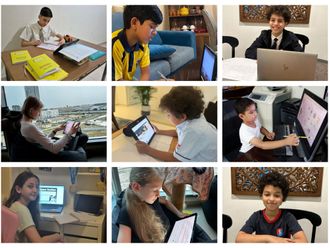When you see a group of students glued to their smartphones, it might be unfair to automatically assume they are Whatsapping or Facebooking away. Chances are, they might be reading up on Quantum Mechanics, or brushing up their Business 101 skills for an upcoming class test.
Mathew Boice, Vice-President Middle East and Africa at Ellucian, a leader in higher education technology, providing software and services to institutions, explains that technology has impacted the entire chain, from streamlining administrative processes to enhancing the student experience. “Innovation in technology offers students more flexibility from both a learning and administrative perspective. Today, faculty and students can interact and exchange learning materials on a wider number of channels,” he says, adding that technology is also playing an important role in talent management and student recruitment.
Meanwhile, even the admission process is getting an upgrade. Matthew Poyiadgi, Vice-President — EMEA at Pearson VUE, says computer-based testing for university admissions is becoming more widespread. Instead of attending a centrally-located test centre, candidates book a test on demand at a centre local to them, booking again if they need to resit the exam. Results are received instantly after the test. “It is important for universities to offer this increased candidate convenience — the cost of courses has been rising, and there is increasing competition between universities, meaning greater pressure to provide the best selection tests,” he says.
Boice adds that a great number of institutions in this region are already tech-savvy, “which is good news for students and the regional higher education sector”.
GN Focus looks at five key trends reshaping the sector.
24x7 remote access
Boice says today’s students are “much more mobile and tech-savvy” and expect educational institutions to keep up with the latest trends. “Mobile technology allows students on-the-go access to university networks and services including class registration and scheduling, as well as access to learning materials,” he says, adding that students can also access administrative services outside office hours and are free to manage their courses, check grades, and obtain entry into library and other academic databases. Mariam Shaikh, Vice-President, Student Recruitment and Admissions at Amity University Dubai, also believes that institutions have warmed up to BYOD, where students bring their own hardware. “Higher education institutions are finding that when given the opportunity to choose their device, users are saved from the effort and time needed to get accustomed to new devices and can therefore accomplish tasks with more ease and efficiency,” she adds.
Analytics and insights
Shaikh says learning analytics is an area where the impact of higher education has been felt the most — there is higher interest in using new data sources for personalising the learning experience, for ongoing formative assessment of learning, and for performance measurement. “The goal is to build better pedagogies and empower students to take an active part in their learning.”
Multiple forms of delivery
Tablets, phones and ebook readers — students engage multiple delivery tools during the study process today. Boice describes it as “the campus extending itself right into the student’s hands”. Meanwhile, coursework is more diversified as well, with students going through videos, podcasts, and blogs. Daniel Adkins, Academic Director at Murdoch University Dubai, adds that realistic simulations can serve as a valuable teaching aid. “Technology simply provides a few more tools in the toolbox and an automated way of doing things that [students] were already doing.”
Cross-border collaboration
Learners based in different parts of the world collaborate on university projects in real time, made possible through technology. “Such flexibility results in a more empowered faculty and student body that now work together outside of the limitations of campus,” says Boice. Adkins mentions another form of collaboration — class polling — where lecturers get real-time feedback from the entire class about the pace of the lecture and whether or not a concept has been understood.
Flipped high-tech classrooms
Why waste time going over material that is already available online and elsewhere? Shaikh notes that the very concept of a lecture is being radically overhauled, and in the new paradigm class time is used for deeper dives, discussions and quizzes. For information assimilation, students are expected to do the grunt work on their own time, by proactively watching pre-recorded lectures, listening to podcasts or collaborating online with peers. Classrooms and learning spaces are also undergoing a facelift, as institutes leverage the latest research findings and technologies. Blended learning combines sophisticated multimedia technologies with old-school face-to-face instruction methods, while the traditional podium and rows of seats in the room have given way to layouts that focus on collaboration. And data and Wi-Fi connectivity has brought more options to the table — including video conferencing, voting pads and electronic boards. In fact, Shaikh believes that university classrooms will increasingly look like “real-world work and social environments that facilitate interaction and cross disciplinary problem-solving”.












